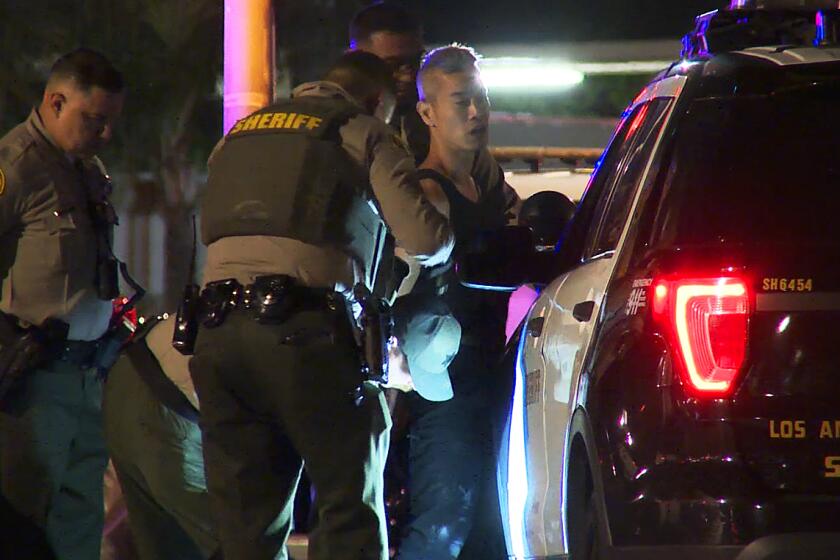Downtown L.A. art that’s less — and more — than it appears
Four straight rows of four palm trees each stand on the northeast corner of 2nd and Spring streets downtown — a block from Los Angeles City Hall, right alongside LAPD headquarters.
They’re directly across from the newsroom. I stare out at them from my desk.
Lately they have come to look like hourglasses running out of time.
Small tufts of green fronds reach to the sky. Ample brown ones drag down toward the dirt.
Will the dead fronds ever be trimmed? Would it make a difference? Are the trees dying?
The questions frustrated me until a couple of weeks ago, when a sign appeared offering an explanation.
It bore the city seal and signatures of the mayor and the director of the Museum of Contemporary Art. And it informed me that the palms were an art installation whose bedraggled appearance was intentional.
“Thirsty Palms,” it said, had been created by L.A. artist Chris Burden, whose “Urban Light” at the Los Angeles County Museum of Art features rows of restored city street lamps.
The palm grove, the sign said, had been “purposely under-watered … in sympathy with all those whose daily existence is a struggle for survival.” It was, I read, part of a city program called “Art Appears,” “which brings great art to public spaces in Los Angeles … engaging people outside the museum setting.”
When I first came upon the sign, I stopped just long enough to read it and think that this edgy public art program might make a good story. So I snapped a photo as a reminder to find out more.
Once back at my desk, I was about to do just that when I burst out laughing instead.
I’d been had, it suddenly hit me, and there had been so many clues, some plain to see in my cellphone snapshot.
The legend read “Thristy Palms,” not “Thirsty Palms.” “Thristy Palms” and “Urban Light” had nothing more in common with each other than objects aligned in straight rows. The sign also couldn’t have been flimsier. On closer examination, it was just a piece of paper laminated in clear plastic and glued onto a plain cardboard box stuck on a thin, unpainted wooden stake.
Still, it had managed not only to fool me but to tilt my perspective. Suddenly everything around me looked off-kilter, ripe with subversive potential.
I started imagining where other ersatz signs might appear. I thought one might go on the tall chain-link fence currently surrounding the new City Hall lawn, replanted at great expense after the wear and tear of Occupy LA. Maybe it might say the fence wasn’t a fence at all but a sculpture symbolizing how the 99% are shut out from the lush world of the 1%.
It turned out there were, in fact, other such signs scattered downtown — attributing graffiti on a downtown dumpster to Jean-Michel Basquiat and Andy Warhol, and informing the public that a construction site actually was an archaeological dig to remove “a remarkably well-preserved female Pterodactyl skeleton.”
“Art Appears” is not a city program. But art of this sort has been appearing all over downtown of late — much of it, signs included, the work of a street artist who calls himself Wild Life and who specializes in the double-take.
The pieces aren’t subtle. They’re easy to grasp. And their life span usually is short — here one day, gone the next.
Still, to me, they are shape-shifters, which even after they vanish leave traces. They provide an alternate script for downtown, more spontaneous, more mysterious, less staid.
That may be what Wild Life is after. It’s hard to know. He makes himself available only through an intermediary, Stephen Zeigler, the owner of 118 Winston, a downtown creative space that hosts art exhibits, yoga classes and other events. I sent Zeigler questions. He sent me responses, which he said Wild Life had dictated to him. (In this world of make-believe, of course, who’s to say for sure.)
In any case, when I asked if Wild Life had anything particular he was trying to say about the city, the response I got was, “The whole project is an exercise in irony.”
In May, Wild Life and another artist, Calder Greenwood, placed a family of papier-mache sunbathers at the bottom of a large construction pit, stretching a block square north to south between 1st and 2nd streets and east to west between Broadway and Hill Street.
Ever since they appeared and quickly disappeared, I’ve been pining for that empty lot — slated for a federal courthouse — to remain open space, its view of Walt Disney Hall’s shimmering waves of stainless steel unblocked by another blockish government office building.
When Greenwood and Wild Life planted a leafy green tree, one-dimensional, painted on wood, on a stump along a barren stretch of parking lots on Spring Street, I felt the full starkness of that scorched sidewalk, un-green, bereft of shade, unwelcoming. Now I can’t walk it without longing to see real trees there one day.
Speaking of trees, Wild Life’s “Thristy Palms” left me hungry for news of their actual state of health.
Kevin Regan, assistant general manager for city’s Department of Recreation and Parks, sighed and told me it had been a long, messy saga.
His department, he said, wasn’t involved in the landscaping of the LAPD headquarters, which opened in 2009. As years passed, he said, it became clear that there were big problems with some of the plantings. Bermuda grass, hard to eradicate, invaded rosemary beds installed along Spring Street. As for the 16 drought-tolerant Washingtonia palms, something — soil, drainage, both? — clearly is keeping them from thriving.
There’s going to be a major overhaul, which the Bureau of Engineering is just beginning, he said. It will involve major replanting and remediation. Until then, he said, there’s no point for Recreation and Parks, which for the first time received money to tend the area in July, to do anything beyond “minimum maintenance.”
“I’m pretty sure that it will all get straightened out and that it will start looking better eventually,” Regan told me.
Until then, I will stare out my window “in sympathy with” my “Thristy Palms,” “whose daily existence,” just as the sign said, really is “a struggle for survival.”
More to Read
Start your day right
Sign up for Essential California for news, features and recommendations from the L.A. Times and beyond in your inbox six days a week.
You may occasionally receive promotional content from the Los Angeles Times.







